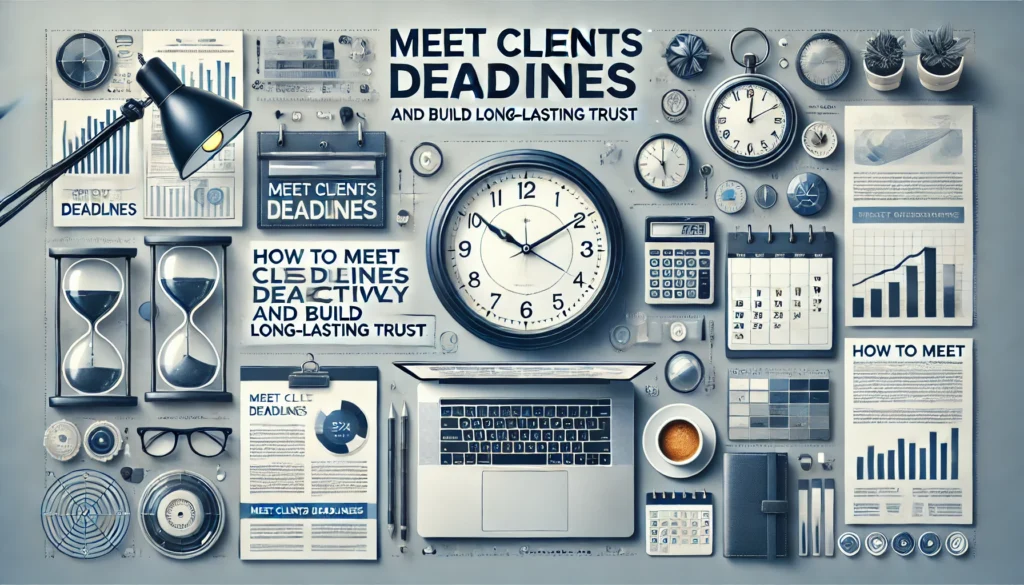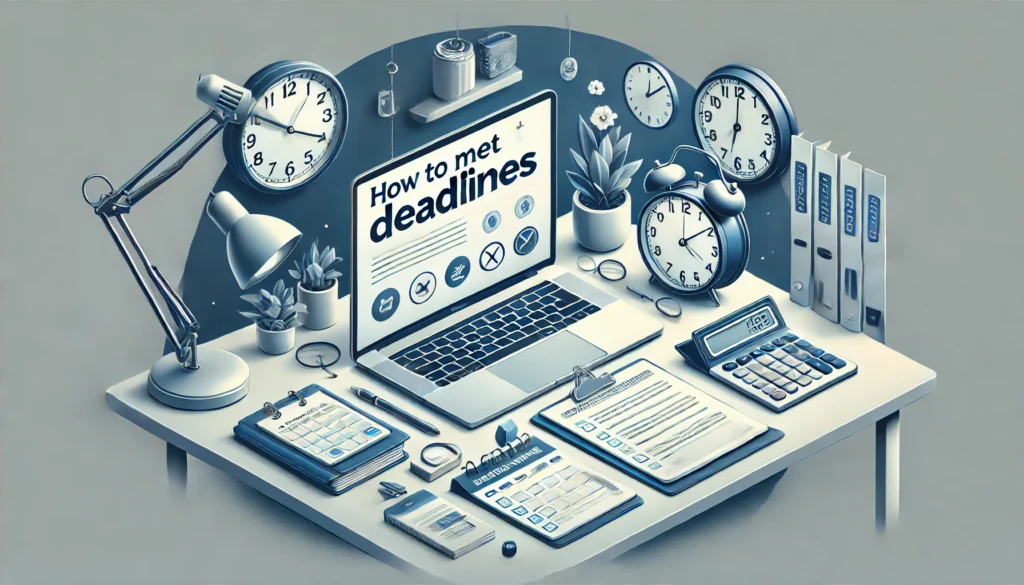Meeting clients deadlines is one of the most important aspects of maintaining a successful business relationship. Whether you’re a freelancer, a small business owner, or part of a larger organization, timely delivery is the cornerstone of client satisfaction. When you meet clients’ deadlines consistently, you show reliability, build trust, and foster strong professional relationships that can lead to repeat business and glowing referrals.
In this blog, we’ll explore strategies to help you meet clients’ deadlines without compromising on quality. From planning and prioritization to managing expectations and overcoming challenges, we’ll cover everything you need to know to deliver your best work on time.

Table of Contents
Why Meeting Clients Deadlines is Crucial
Deadlines are more than just dates on a calendar. They represent a commitment to your clients and set the foundation for professional trust. Here are a few reasons why it’s vital to meet clients’ deadlines:
- Builds Client Trust: Consistently delivering on time shows that you value your client’s time and business.
- Enhances Reputation: When you meet deadlines, word spreads, enhancing your professional image.
- Avoids Financial Penalties: In some cases, missed deadlines can lead to financial losses or penalties.
- Improves Productivity: Deadlines provide structure, helping you stay focused and efficient.
Now that we understand the importance, let’s dive into actionable tips to ensure you always meet clients’ deadlines.
How to Plan and Prioritize to Meet Clients Deadlines
- Understand the Requirements
Before starting any project, take the time to understand what the client needs. Ask questions, clarify expectations, and document everything. A clear understanding of the project scope ensures that you’re on the same page with your client. - Set Realistic Deadlines
Avoid overpromising. If a client requests a short timeline that feels unachievable, communicate your concerns and propose a realistic deadline. It’s better to negotiate upfront than to disappoint later. - Break Down the Project
Divide the project into smaller tasks and set mini-deadlines for each. This approach not only makes the project more manageable but also helps you track progress effectively. - Prioritize Tasks
Determine which tasks are most urgent and tackle them first. Use prioritization techniques like the Eisenhower Matrix to categorize tasks based on urgency and importance.
Effective Time Management Strategies
Time management is key to meeting clients’ deadlines. Here are some strategies to help you manage your time effectively:
- Use a Project Management Tool
Tools like Trello, Asana, or Monday.com can help you organize tasks, set deadlines, and monitor progress. - Create a Daily Schedule
Plan your day with a to-do list. Allocate time blocks for specific tasks and stick to the schedule. - Minimize Distractions
Identify and eliminate distractions. Turn off non-essential notifications, create a dedicated workspace, and practice focus techniques like the Pomodoro Technique. - Delegate When Necessary
If you’re part of a team, delegate tasks based on individual strengths. Delegation can lighten your workload and improve efficiency.
Communicating Effectively with Clients
- Set Clear Expectations
Be upfront about timelines and deliverables. Let the client know when they can expect updates and final results. - Regular Updates
Keep clients informed about your progress. Regular communication builds trust and allows you to address any concerns early on. - Manage Scope Creep
Sometimes, clients request additional tasks during a project. Politely explain how these changes may affect the timeline and propose adjustments accordingly.
Overcoming Challenges to Meet Clients Deadlines
- Plan for Unexpected Delays
Life happens, and unexpected delays are inevitable. Build a buffer into your timeline to account for unforeseen challenges. - Stay Flexible
Adaptability is key. If something goes wrong, reassess your plan and make necessary adjustments to stay on track. - Seek Help When Needed
Don’t hesitate to ask for assistance if you’re struggling. Whether it’s from a colleague or an external resource, a fresh perspective can help you overcome roadblocks.
The Role of Quality in Meeting Clients Deadlines
While meeting deadlines is important, quality should never take a back seat. Here’s how to balance the two:
- Prioritize Accuracy
Rushing to meet a deadline can lead to errors. Double-check your work before submission. - Set Quality Benchmarks
Define clear quality standards for your work and adhere to them, even under tight deadlines. - Request Feedback
After delivering your work, ask the client for feedback. This helps you learn and improve for future projects.

Proven Techniques to Stay on Track
- Work Backward from the Deadline
Start with the final deadline and work backward to create a timeline for each task. - Avoid Multitasking
Focus on one task at a time to ensure better quality and faster completion. - Monitor Progress
Use tools and techniques to track your progress and identify bottlenecks early.
The Benefits of Meeting Clients Deadlines
Consistently meeting deadlines offers numerous benefits:
- Strengthens client relationships.
- Boosts your professional credibility.
- Increases chances of repeat business.
- Helps you stand out in a competitive market.
Conclusion
Meeting clients’ deadlines is not just about ticking off tasks on a to-do list; it’s about honoring commitments, building trust, and delivering value. By planning effectively, managing your time wisely, and maintaining clear communication, you can ensure timely delivery without compromising on quality.
Remember, the key to long-term success lies in your ability to consistently meet clients’ deadlines. With practice and dedication, you can turn this skill into a defining strength that sets you apart.
FAQs on Meeting Clients Deadlines
Q1. Why is meeting clients’ deadlines important?
Meeting deadlines is crucial for building trust, enhancing your reputation, and maintaining professional relationships with clients.
Q2. How can I improve my time management skills?
Use project management tools, create daily schedules, minimize distractions, and prioritize tasks effectively.
Q3. What should I do if I can’t meet a deadline?
Communicate with the client as soon as possible, explain the reasons, and propose an alternative timeline.
Q4. How do I handle scope creep?
Politely explain how additional tasks may affect the timeline and suggest adjustments to accommodate the changes.
Q5. How do I balance quality and speed?
Set quality benchmarks, double-check your work, and build buffer time into your schedule to maintain both quality and timeliness.
By following these tips and strategies, you’ll not only meet clients’ deadlines but also exceed their expectations, ensuring long-term success in your professional journey.



